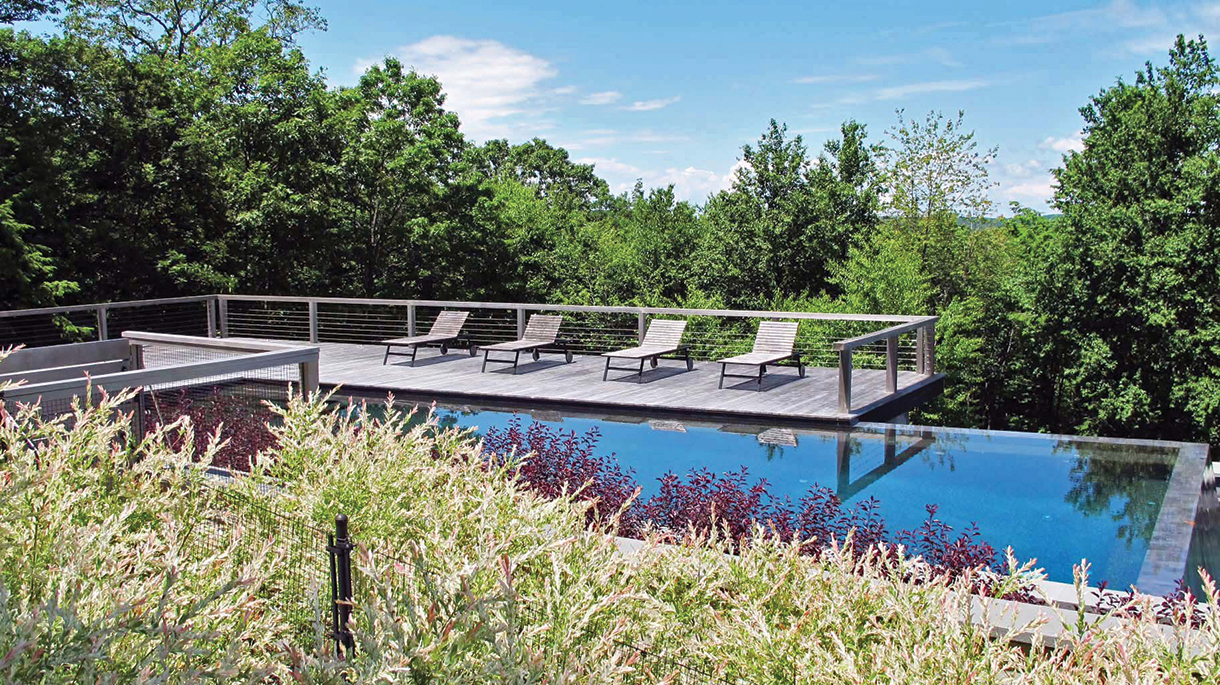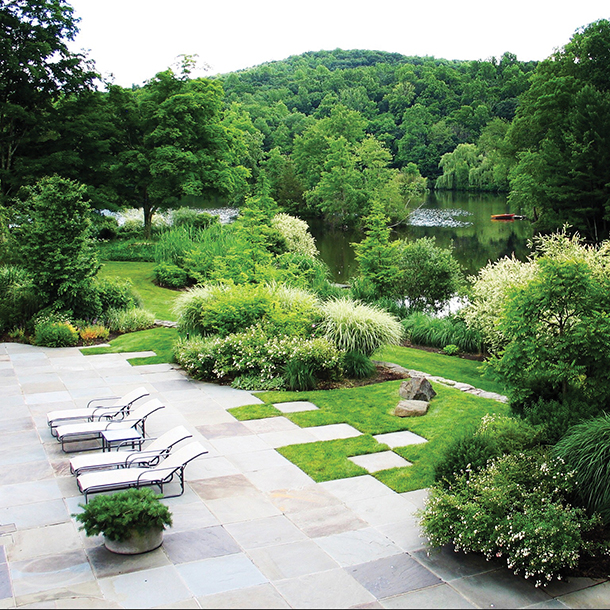
Where the Garden Grows
The new, high-end, all-natural approach to landscape design is all about a toxin-free, earth-friendly commitment to sustainability and longevity—for plants and people.
A Manhattan financier couldn’t quite shake the feeling that something wasn’t right. On his regular hikes through the wilderness of his sprawling new home in a gated community on Martha’s Vineyard, he kept spotting plants that seemed, somehow, out of place. A few quick searches on his smartphone and he was crestfallen: Those Eden-like surroundings were not the centuries-old countryside he’d assumed, but manufactured landscapes featuring reams of invasive species, plants from Europe and elsewhere across the world. Even worse, the local gardeners warned him that maintaining such lushness would require regular applications of industrial-grade herbicides and poisons. Horrified, he turned to Claudia West for a better solution.
West wasn’t fazed. She’s the co-founder of Arlington, Virginia–based landscape architects Phyto Studio (phytostudio.com), a firm that specializes in creating high-end gardens without using a drop of pesticide. She began working with the United States National Arboretum in Washington, D.C., to devise a replanting program and adopted a mowing strategy of natural ways to winnow down the invasives that were choking the meadow; for example, to hit the undesirable species at their most vulnerable time to prevent them from forming seeds. Controlled burning is another all-natural tool; American ecosystems evolved as so-called fire ecologies, with native species able to rebound after a prairie or forest fire. Plants and grasses that emerged in Europe did not develop the same resilience, so can be curtailed with judicious controlled burns. “The tools we use to gain a competitive advantage for the desirable species aren’t Roundup—they’re ancient knowledge,” she says. “And it’s not only for the birds and the bees. It’s about giving you something back, personally. Caring for the land wakes up something primeval in people, a deep gratification.”
West is one of the leading proponents of a new, environmentally sensitive and holistic approach to high-end landscaping, one that champions a back-to-the-future approach to plant management. “Many of my clients have the financial resources to demand the luxury of a safe landscape—that’s what it boils down to,” she adds. “A safe landscape is one that it’s OK to walk through without worrying what gets on your feet. That’s what is a luxury now.” She focuses on holistic planting systems that mimic how plants grow in the wild; her designs aren’t naturalistic by default, though—many are formal and clean, using density of planting in lieu of chemicals, for instance. “If a good plant already grows in the spot, there’s no room for a weed,” she laughs.


West isn’t alone in championing such an approach—just look at Edwina von Gal, one of the foremost landscape designers in the Hamptons, who counts Calvin Klein and Ina Garten among her clients. Von Gal, a longtime all-natural garden advocate, has devoted much of the last few years to operating the Perfect Earth Project (perfectearthproject.org), a nonprofit with a single mission: helping others adopt similar earth-friendly approaches. Von Gal has paid particular attention to lawns, which are notoriously difficult to maintain without resorting to chemicals; to do so, she warns, the average home landscape uses two to four times more of those toxins per square foot than a commercial farm. “Then it gets on your clothing, it comes into your house, and it’s with you for years.” She likens much lawn-tending to the garden equivalent of a bad face-lift because the owner is trying to prevent the landscape from ever looking older. Instead, allow grass to grow a little longer, to protect its roots from the sun, and use a mulching mower that will leave clippings on the lawn to replenish the soil.
Von Gal has persuaded clients like the notoriously picky Klein to adopt such practices in their own gardens, often going beyond simple plant-tending to do so, like the recent meeting she had with a real estate broker. “My client, who raises money for environmental causes, was bamboozled by her broker who told her that she couldn’t rent her house if she didn’t use chemicals on her lawn and garden,” says von Gal. “So, I asked the broker to come to a toxic-free lawn that’s safe and healthy so she could maybe merchandise the house in that way—as one that’s clean inside and outside.” Von Gal’s next initiative, launching this fall, is a campaign she’s dubbed Two Thirds for the Birds; it challenges landscape design professionals to commit to including at least 70 percent native plants in all of their projects and swearing off pesticides. Such ecosystems are better able to support the local birds, in part because they’re better hosts for the insects on which those birds feed.
New York City–based David Kulick of Zone6 Design (zone6design.com) is another proponent of this high-end, all-natural approach. The onetime professional dancer turned landscape designer and horticulturist stresses the importance of biophilia. “We need contact with nature just as we need exercise, food, air, and water to thrive,” Kulick says. He recently took over a large rooftop garden on Park Avenue. The owner asked him for ideas on how to reduce the maintenance, as the trees needed to be sprayed every week. Kulick was horrified, but quickly realized why: the gorgeous Himalayan white birches that made up the majority of the greenery were ill-suited to a hot New York rooftop. Instead, he suggested swapping them out for black pines and ornamental grasses, both of which would thrive in those conditions without interventions; beige flat-bottomed planters—better to stay stable in high winds—now dot the space in an installation he calls “cubist dunes.” Other techniques Kulick champions include using high-pressure water, rather than chemicals, to wash aphids off roses, and treating apple orchards with mineral oil in early spring—a spray of the mineral oil will smother the eggs of pests before they hatch.
Garden management like this isn’t a quick fix, but rather a long-term approach to landscaping, with efforts growing more evident over time. “Clients want a landscape to be more than just a status symbol or a decoration these days,” says Phyto Studio’s West. “So many of them, working in high-stress environments and not sticking around in one place for a very long time, want a landscape that’s immersive and restorative—not just pretty, but evocative and deeply emotional. It’s about reminding us of the perfect world that used to be.”




